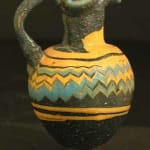Sand-Core Formed Glass Oinochoe, 6 Century BCE - 4th Century BCE
Glass
2.875
GF.0348
Further images
Beginning in the seventh century B.C., the manufacture of sand-core vessels was revived in large scale in Egypt and the Near East. Although the techniques and colours suggest imitations of...
Beginning in the seventh century B.C., the manufacture of sand-core vessels was revived in large scale in Egypt and the Near East. Although the techniques and colours suggest imitations of the New Kingdom vessels, new non-Egyptian forms were introduced to reflect the development of Greek pottery shapes.
This diminutive vessel must have once contained a most rare and precious substance, be it fragrant perfume or healing ointment. Cobalt blue in colour, it rests on an outsplayed foot that is slightly convex below. It has rounded shoulders, a cylindrical neck, trefoil mouth, and a single handle. Opaque yellow and turquoise threads have been wound spirally on the body and then tooled into a zigzag pattern in the middle band. Furthermore, the edges of the foot and the rim have been decorated with a turquoise thread.
Vessels of this type continued to be produced until the first century B.C.
This diminutive vessel must have once contained a most rare and precious substance, be it fragrant perfume or healing ointment. Cobalt blue in colour, it rests on an outsplayed foot that is slightly convex below. It has rounded shoulders, a cylindrical neck, trefoil mouth, and a single handle. Opaque yellow and turquoise threads have been wound spirally on the body and then tooled into a zigzag pattern in the middle band. Furthermore, the edges of the foot and the rim have been decorated with a turquoise thread.
Vessels of this type continued to be produced until the first century B.C.











